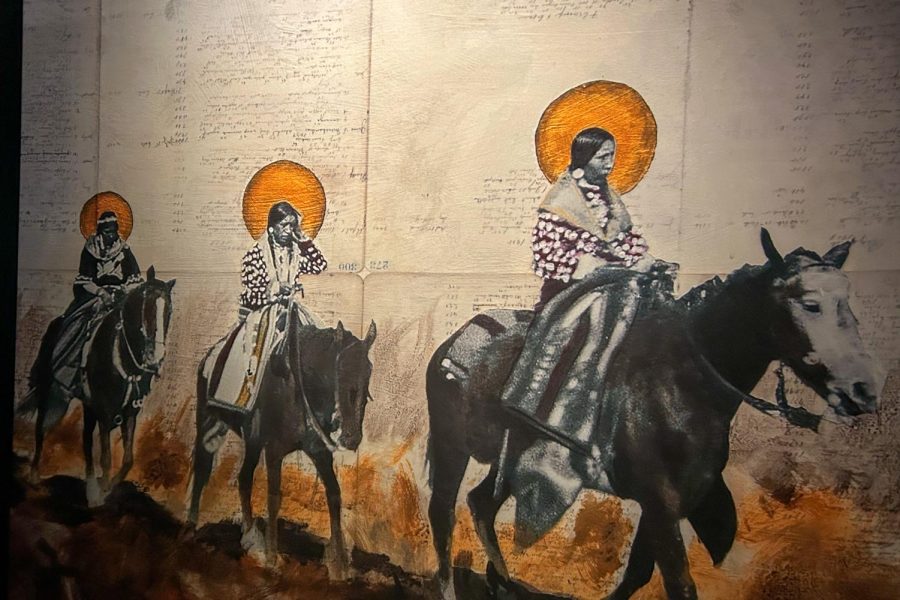‘Apsáalooke Women and Warriors’ exhibit celebrates Native American history, power of women
Alyssa Carnevali | Staff Photographer
An art piece at the “Apsáalooke Women and Warriors” exhibit at the Carnegie Museum of Natural History.
February 16, 2023
When museum-goers visit the “Apsáalooke Women and Warriors” exhibit at the Carnegie Museum of Natural History, they experience a narrated exhibition that explains the history of the tribe. Apsáalooke, or “Crow people” in English, women overlook warrior shields that trace the origins of the tribe to modern day.
Nina Sanders, a member of the Apsáalooke, is both the curator of the exhibit and the exhibit’s narrator who describes the history of the Apsáalooke in their native language through a recording.
“Apsáalooke Women and Warriors” runs in the Carnegie Museum from Feb. 4 to May 29. It portrays the women as protectors of their tribe and culture. The materials in the exhibit highlight the cultural richness, tenacity and the strength of the Apsaalooke people, especially their women.
Sanders, the curator and a descendant of one of the makers of the shields, said in a press release that the tribe believed that the shields contained spiritual power that helped maintain strength, both on the battlefield and in daily life.
“The shields inspire us, they remind us that people have the ability to defy the laws of physics and change the course of nature and history,” Sanders said. “The shields represent superhuman potential and divine intervention.”
A combination of descriptive plaques, music and a recording of Sanders’ voice guides visitors through the exhibit in a chronological manner. Viewers experience the artwork as an ongoing story of the Apsáalooke people.
The exhibit describes their historical traditions and spiritual beliefs, such as “coup,” or acts of bravery in war against enemies and egalitarian views on the three genders — bía, meaning woman, bachee, meaning man, and batee, or two-spirited. It also depicts the celebration of surviving struggles of colonialism, known as “Baaihkammáache.”
For 32-year-old Lancaster resident Allison Mann, this cultural coexistence of pain and perseverance struck her the most during her visit to “Apsáalooke Women and Warriors.”
“I think seeing an exhibit like this helps not erase everything. It’s not so much like a page in the book, more like these are people who lived who have family members, who still do, who carry on the negative history as well as the positive,” Mann said.
With a wide range of historical and modern indigenous art from the Apsáalooke people, including sculpture, painting, beadwork, clothing, shields, photography and multimedia, Sanders seeks to tell the story of her people’s bravery, innovation and spiritual beliefs and the vital role women have played in achieving those feats.
Gretchen Baker, the director of Carnegie Museum of Natural History, said she values Sanders’ narration of the tribe’s story.
“Curator Nina Sanders and numerous collaborators have woven together rich historical accounts with contemporary stories through stunning objects and visuals,” Baker said. “This is a profound exhibition that highlights and invites connection to often hidden narratives — those of women and Indigenous Native American cultures.”
Abby Heines, a 27-year-old former Carnegie Museum employee, urges people, specifically those who are not Native American, to check out the exhibit.
“Since I’m kind of a museum buff, we’ve been all over the world, it’s really cool to see something like this that’s very modern but ties into all this history,” Heines said.
The combination of historical lessons written in the plaques, artifacts, artist statements and, of course, the very voice of Sanders herself, narrating her people’s history, provides the people of Pittsburgh with an opportunity to learn about the Apsáalooke and Native American art.
“I feel like there’s a lot of shame as white people to learn about this stuff, but it’s not in an attacking way — it’s in a celebration way,” Heines said. “You don’t have to feel guilty. It’s not ancient history. We should be lifting up other voices and this is important to lift it up, not be shameful.”








